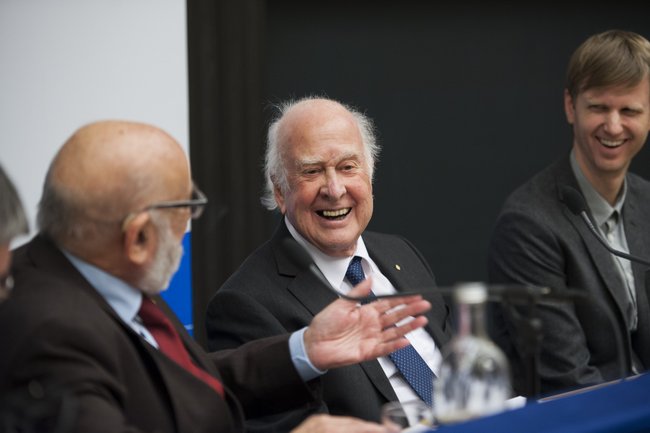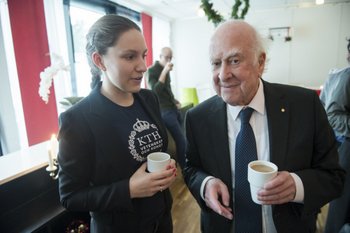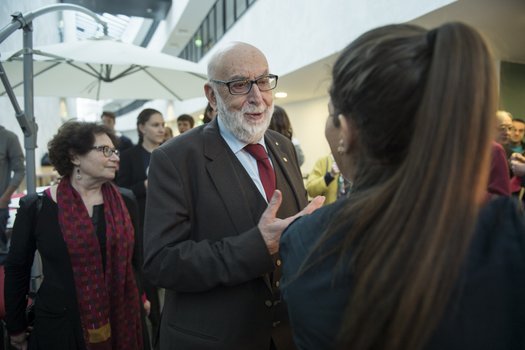Nobel stars light up AlbaNova
Nobel Prize
They were outsiders in the world of quantum field theory 40 years ago. But on Saturday Peter Higgs and François Englert were greeted like rock stars when they arrived at AlbaNova University Center.

An icy winter chill bore down upon Stockholm, as close to 300 students and staff from KTH and Stockholm University packed into the Oskar Klein auditorium at AlbaNova University Center for the city’s hottest event – a Q&A with the Nobel laureates, Higgs and Englert. The event was co-hosted by KTH Royal Institute of Technology and Stockholm University.

Joined by Dave Charlton, the head of CERN’s Atlas Project, and KTH Assistant Professor Jonas Strandberg, a member of the Atlas project, the two Nobel laureates electrified the audience with their answers to prepared questions – as well as questions from the audience – about the origins of their theory, the discovery of the Higgs boson at CERN, and of course, future plans for studying the particle.
The audience sat rapt as Higgs’ and Englert’s recounted the questions and process that lead them to publish their theories in 1964. The scientists also admitted that at the time they were “outsiders” in the world of quantum field theory, which they said had fallen “out of fashion” by that point.

"I moved into particle physics and quantum field theory after my PhD, which was something quite different,” Higgs said. “I think it was useful to be outsider, because I didn’t fully accept the fashionable prejudices of people who got their PhDs in this area and knew what was the right direction in which to go – the sort of orthodoxy of the field.
“My colleagues in 1964 thought I was certainly eccentric – and maybe a crank,” Higgs said.
Englert concurred that being out of step with the establishment worked in their favor. "We had the virtue of being ignorant ... sometimes it's good not to know things," he said.
"We were not physicists of the elementary particle; we didn’t know what people in elementary particle thought was important or not. We just looked at what we thought was important,” he said.
As one would expect, men who study the relationships between particles are, well, particular about the way they form their answers. Outside the lecture hall, Higgs was asked whether the discovery of the Boson could lead to new research opportunities, in such areas as material science or energy. “The discovery is really a matter of particle physics and to some extent its relationship to cosmology,” Higgs said. “This is something quite the wrong energy scale for any kinds of condensed matter type materials, even though the theory came out of condensed matter physics.”
Following the discussion, the scientists received gifts and flowers from the event’s sponsors, KTH and Stockholm University. They also greeted students and staff who streamed down the aisles to crowd around the lectern. Higgs was seen signing a Swedish flag for one student.

KTH Physics student Ksenia Chechet said the discussion was inspiring and motivating. “It was a great feeling that some of the topics mentioned by the Nobel laureates are things that we encounter in our classes at KTH, which means that we get the chance to learn about the forefront of particle physics,” Chechet said.
Sylvain Julien-Laferrière, was similarly affected. “I was really appreciated their spontaneity and how simply they are talking about difficult topic,” he said, adding that he was able to get his photo taken with Higgs. “Taking a picture with Peter Higgs was beyond my expectations.
“It was almost like a dream.”
David Callahan
Learn more about the

